
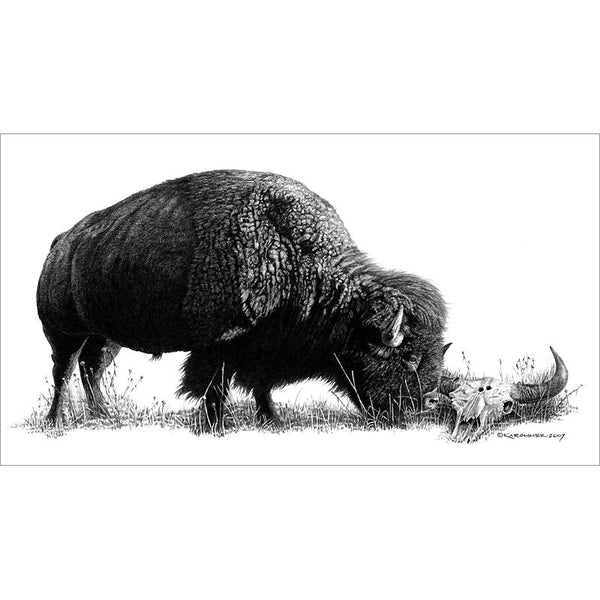
Honoring the Dead - A Pencil Study of Life and Death
$ 75.00
This piece is titled "Honoring The Dead." Like elephants, bison have been witnessed returning to the bones of the "fallen" to pay their respects.Pencil on heavy-weight illustration board.
Dimensions: 10" H x 16" W
Edition of 250. Make your size selection from the drop-down menu.
Original is sold.

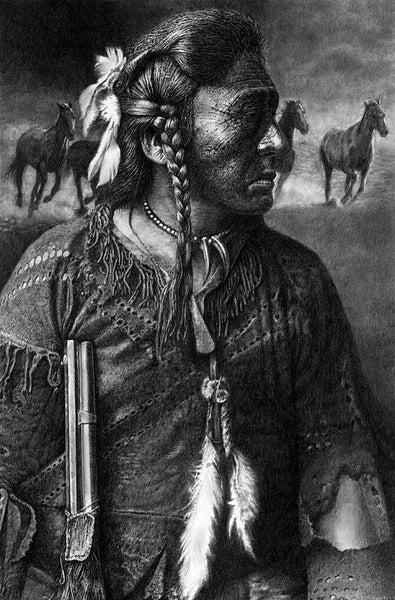
Horse Capture
$ 75.00
Horse Capture was born near Milk River, Montana, in 1858. His tribe, the Atsina, commonly designated Gros Ventres of the Prairie, are of the Algonquian stock and a branch of the Arapaho. Their name for themselves is Aaninen, Atsina being their Blackfoot name.The photographic portrait reference was provided courtesy of the Buffalo Bill Historical Center, Cody, Wyoming, portrait photograph reference was taken in 1909 by Edward S. Curtis.
Pencil on heavy-weight illustration board.
Dimensions: 18" H x 12" W
Edition of 250. Make your size selection from the drop-down menu.
The original was donated and accepted for permanent placement in the Booth Western Art Museum in Cartersville, Georgia, October, 2005.

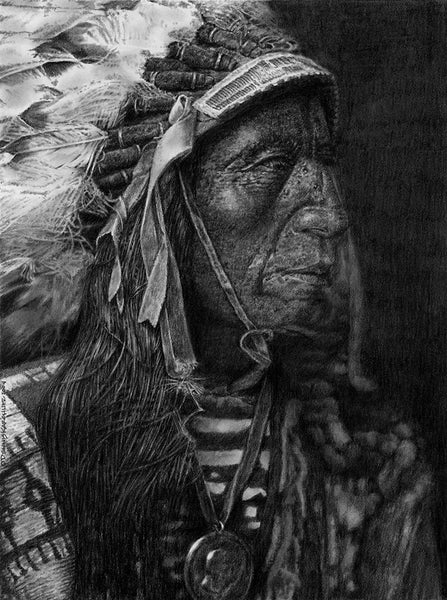
Jack Red Cloud
$ 65.00
This is a "pencil" of "Jack Red Cloud," the Son of the renowned Chief Red Cloud. Jack Red Cloud was an Ogallala chief and an esteemed warrior and orator. A band of the Lakota or Teton Sioux tribe, the Ogallala inhabited the North American Plains and Prairies region west of the Missouri River. The photo used for reference was taken by Edward Sheriff Curtis, circa 1890s.Pencil on heavy-weight illustration board.
Dimensions: 9.75" H x 7.25" W
Edition of 250. Make your size selection from the drop-down menu.
Original is available. $600.00
Inquire today about purchasing the original. Call 307-899-2052 or email.

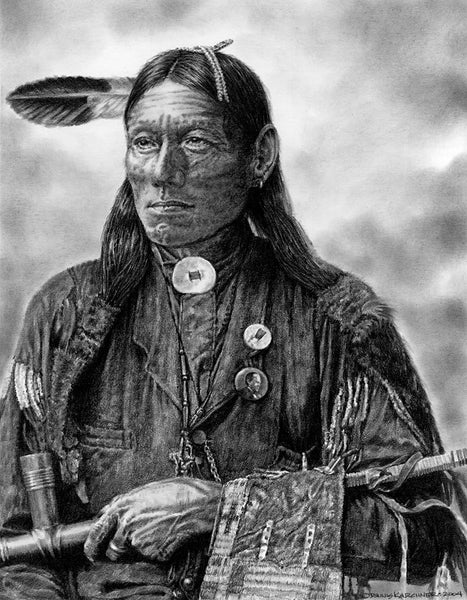
Little Bird
$ 65.00
This is a "pencil" of "Little Bird" an Arapaho which was drawn using a photograph for reference taken by photographer, Frank A. Rinehart.What an honor, Karchner recently received an email from Little Bird's great granddaughter Loretta Little Bird Steele. She was able to shed some light on her great grandfather. She said the portrait of Little Bird was taken at the TransMississippi & International Exposition in 1898.
There are a couple things about this portrait worth noting. Very strangely, "Little Bird" is wearing a crucifix around his neck. The other thing worth mentioning, it looks like he is wearing a political pin on his lapel. Loretta Little Bird Steele believes the picture is of William McKinley (1843-1901) who was president 1897 to 1901. What a great face and a fantastic study!
Pencil on heavy-weight illustration board.
Dimensions: 9.5" H x 7.5" W
Edition of 250. Make your size selection from the drop-down menu.
Original is available. $600.00
Inquire today about purchasing the original. Call 307-899-2052 or email.

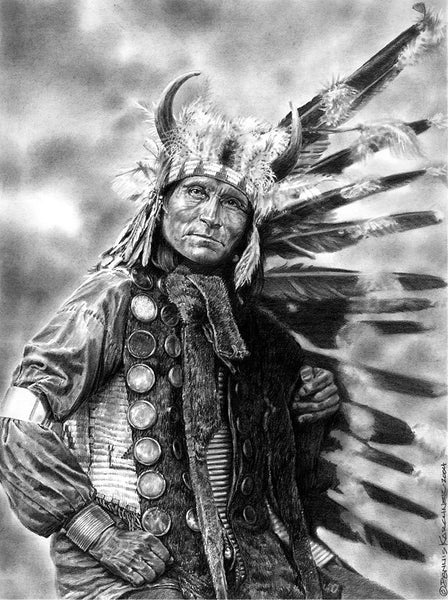
Little Horse
$ 65.00
This is a pencil of "Little Horse," an Ogallula Sioux. Photographer Frank A. Rinehart (1862-1928) took the photo used for reference. The photograph was taken in the year 1899.Pencil on heavy-weight illustration board.
Dimensions: 10.5" H x 8" W
Edition of 250. Make your size selection from the drop-down menu.
Original is sold.

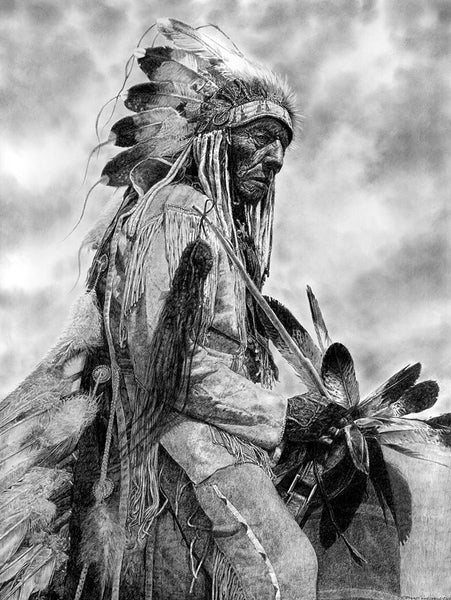
The Old Cheyenne
$ 125.00
This is a "pencil" of "The Old Cheyenne." The reference photograph was taken in 1930 by Edward S. Curtis.
Original on "Clayboard" Masonite.
Dimensions: 18.5" H x 14.25" W
Edition of 250. Make your size selection from the drop-down menu.
Original is sold.

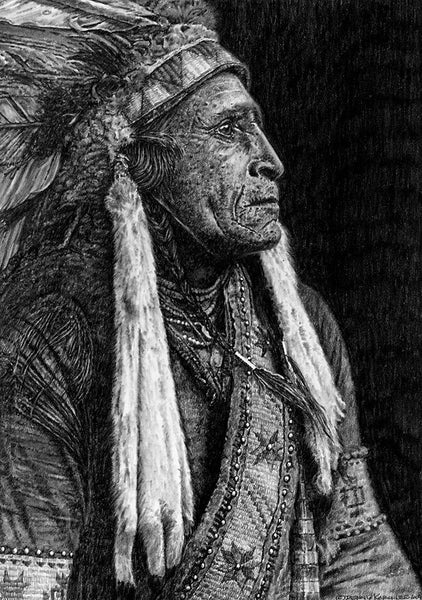
Raven Blanket
$ 65.00
This is a "pencil" of "Raven Blanket,"- Nez Perce. The culturally diverse Nez Perce inhabited the Great Basin region of the United States and were skilled horse breeders and outdoor enthusiasts. The photo used for reference was taken by Edward Sheriff Curtis, circa 1890s.Reference photos made available by the Buffalo Bill Historical Center, Cody, WY.
Pencil on heavy-weight illustration board.
Dimensions: 9.5" H x 6.75" W
Edition of 250. Make your size selection from the drop-down menu.
Original is available. $600.00
Inquire today about purchasing the original. Call 307-899-2052 or email.

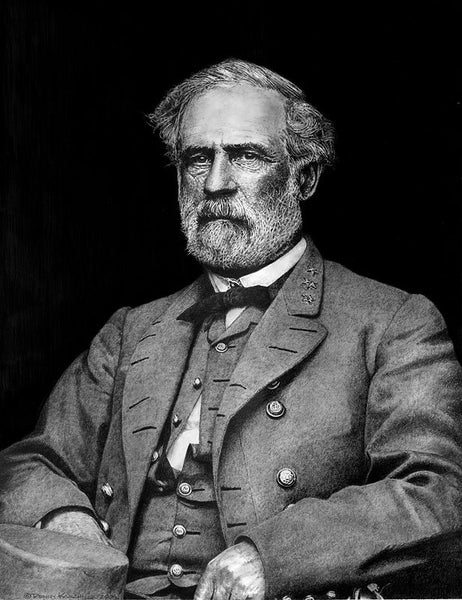
Robert E. Lee
$ 125.00
The stunning pose of this man was taken in 1865, Richmond a week after the general surrendered at Appomattox. It totally captures the Civil War commander's dignity and strength of character--traits that impressed the soldiers of both armies. "All appreciated the sadness that overwhelmed him," recalled Grant's aide, Horace Porter, "and he had the personal sympathy of everyone who beheld him."The photographic reference was taken by the famous Civil War photographer, Matthew Brady.
Original on "Claybord" Masonite.
Dimensions: 18" H x 14" W
Edition of 250. Make your size selection from the drop-down menu.
Framed and matted Original is available. $2700.00
Inquire today about purchasing the original. Call 307-899-2052 or email.

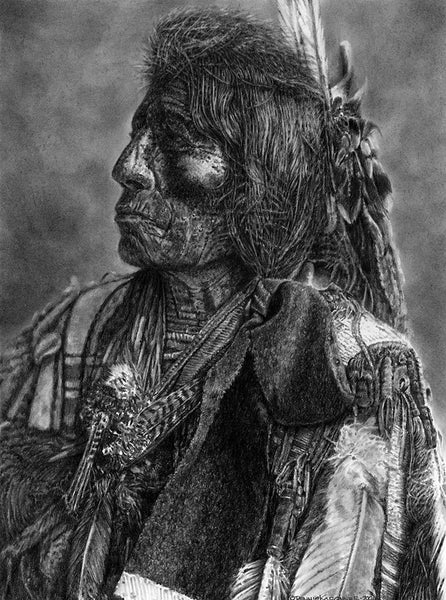
Slow Bull
$ 65.00
This is a "pencil" of "Slow Bull. Born in 1844, Slow Bull was an esteemed Ogallala sub chief and warrior who valiantly fought in numerous battles with the Kootenai, Blackfoot, Pawnee, Shoshone, and Apsaroke. A band of the Lakota or Teton Sioux tribe, the Ogallala inhabited the North American Plains and Prairies west of the Missouri River. The photo used for reference was taken by Edward Sheriff Curtis, circa 1890s.Reference photos made available by the Buffalo Bill Historical Center, Cody, WY.
Pencil on heavy-weight illustration board.
Dimensions: 9.5" H x 7.25" W
Edition of 250. Make your size selection from the drop-down menu.
Original is available. $600.00
Inquire today about purchasing the original. Call 307-899-2052 or email.

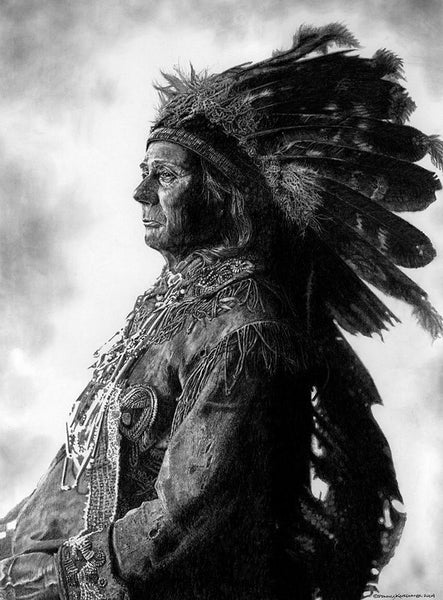
Split Sky
$ 125.00
This is a "pencil" original done of a middle-aged Native American, "Split Sky". This is a larger version of him. Karchner actually started his "Western Collection" with a miniature of "Split Sky." F.W. Glaser, a little-known photographer, took the reference photo that Karchner used to draw from in Brockton, Massachusetts, 1909.Reference photos made available by the Buffalo Bill Historical Center, Cody, WY.
Pencil on heavy-weight illustration board.
Dimensions: 18" H x 14" W
Edition of 250. Make your size selection from the drop-down menu.
Original has been SOLD.

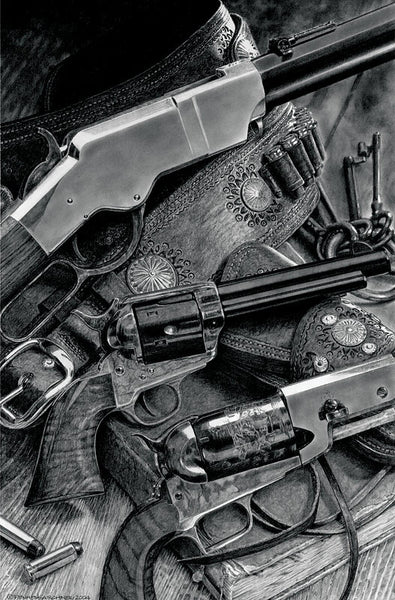
The Three Ubertis
$ 75.00
This "pencil" piece is "The Three Ubertis." Uberti is a gun manufacturer based in Italy. They specialize in the making of fine "Western Vintage Firearms," and are favorites of many collectors and shooters.Pencil on heavy-weight illustration board.
Dimensions: 18" H x 12" W
Edition of 250. Make your size selection from the drop-down menu.
Original donated to the Buffalo Bill Historical Center 2004 Art Auction, Cody, WY--Private Collection.

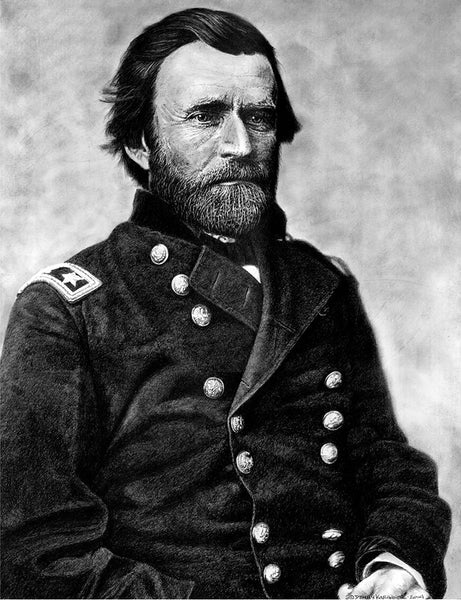
Ulysses S. Grant
$ 125.00
This classic pose of Grant has all of the things that Karchner looks for when he searches for the perfect shot. It has fantastic detail, many, many textures and a look that takes his breath away and hopefully yours too. The photographic reference was taken by the famous Civil War photographer, Matthew Brady in 1863. Brady is the same photographer who shot the fantastic reference that Karchner used to draw Robert E. Lee and General George Custer.The photographic reference was taken by the famous Civil War photographer, Matthew Brady.
Original on "Clayboard" Masonite.
Dimensions: 18" H x 14" W
Edition of 250. Make your size selection from the drop-down menu.
Framed and matted Original is available. $2700.00
Inquire today about purchasing the original. Call 307-899-2052 or email.

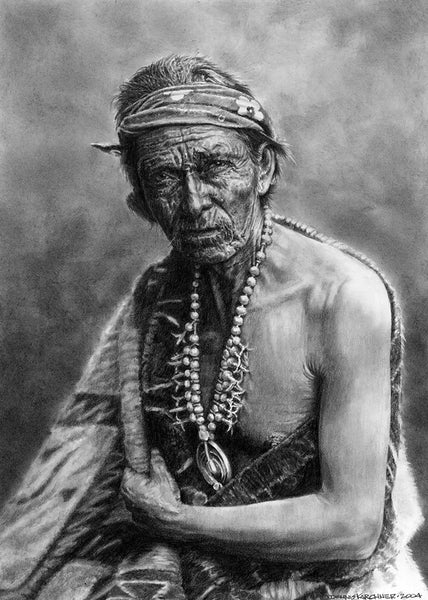
Native American - Untitled
$ 65.00
This is a "pencil" of a noble looking Native American which was unknown. The reference photo was taken by William Marion Pennington. Even the date of the reference photograph was not known. It was probably around 1900.Pencil on heavy-weight illustration board.
Dimensions: 9.5" H x 7" W
Edition of 250. Make your size selection from the drop-down menu.
Original is available. $600.00
Inquire today about purchasing the original. Call 307-899-2052 or email.

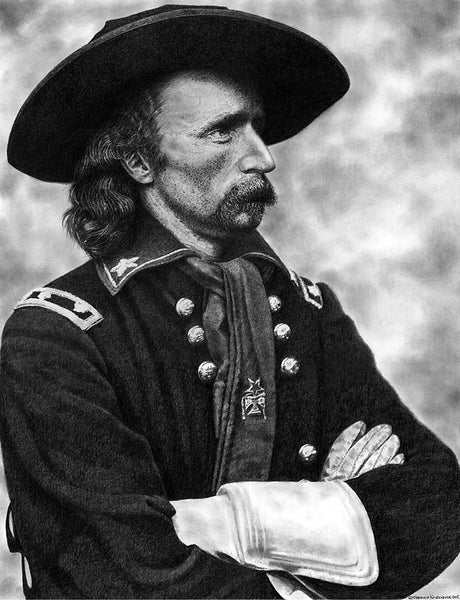
The Yankee Swashbuckler - George Custer
$ 125.00
This is a "pencil" of the cocky, flamboyant and brave, golden-haired George Armstrong Custer. A general at 23, he was one of the Union's most celebrated cavalrymen. By 1865, the time of this reference photo by Civil War Photographer Matthew Brady, he had seen action in most engagements in the eastern theater. A subordinate described Custer as "the idol, as well as the idol of his men, the foremost cavalry officer of his time."With a showdown battle in Pennsylvania anticipated, the colorful 23 year-old George Armstrong Custer was jumped past most of his peers and made a brigadier general by George G. Meade. After Gettysburg, Custer fought other battles. Aside from his Civil War service, he is best known for his defeat and death at the Little Bighorn River on June 25, 1876. This is a postwar portrait, since Custer did not display the insignia of a major general until after April 15, 1865.
Pencil on heavy-weight illustration board.
Dimensions: 18" H x 14" W
Edition of 250. Make your size selection from the drop-down menu.
Original has been SOLD.






